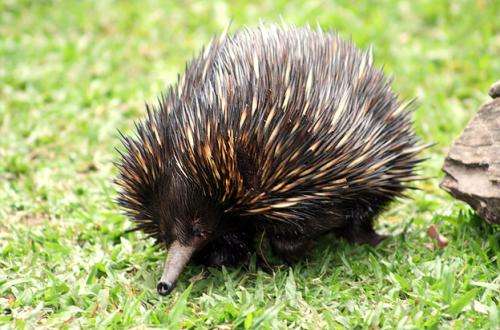Echidna insight into evolution of embryo growth

An international team including University of Adelaide scientists has discovered the molecular change in echidnas enabling both parents to influence the growth of the embryo during pregnancy in mammals.
The authors of this work, published this week in the prestigious journal Science, say this provides insight into the evolution of embryo growth regulation in mammals.
Associate Professor Briony Forbes and Associate Professor Frank Grützner, both from the University of Adelaide's School of Molecular & Biomedical Science, are co-authors of this work, which has been led by researchers at the universities of Oxford and Bristol.
"This research is a great example of how Australia's unique native animals can shed light on mammalian evolution," Associate Professor Grützner says.
"Echidnas and platypuses are unique egg-laying mammals that evolved much earlier than humans, but interestingly they still feature a period of fetal maternal exchange during their short 2-3 week 'pregnancy'. The unique Australian monotremes can therefore be regarded as 'intermediates' between egg-laying birds and intrauterine mammalian development and have been crucial for this discovery."
The change from egg-laying to extended pregnancy sparked the evolution of what scientists describe as a "parental conflict" over the maternal resources provided to the fetus in mammals.
"On the molecular level, the growth factor IGF2 and its inhibitor, the IGF2 receptor, play a central role in this conflict between father and mother, which is thought to result in parent-of-origin dependent gene activity. This means that of the two igf2 gene copies, the one inherited from the father is active, thereby promoting growth and energy extraction from the mother, whereas the mother's copy is inactive, to limit growth of the embryo and save her energy for future offspring," Associate Professor Forbes says.
"For the growth-inhibiting IGF2 receptor, the switch settings are opposite: off from the paternal gene and on from the maternal gene.
"Until now it was unclear how IGF2 and its receptor became involved in this parental 'tug-of-war' found uniquely in mammals.
"This new paper in Science reports the detailed structure of the igf2 receptor in birds, monotremes, opposum and humans, and reveals how the structure of the igf2 receptor protein has changed in mammals in a way that has enabled IGF2 binding and inhibition of its action," she says.
"It is amazing that egg-laying monotremes provide us with such a fascinating new insight into the molecular basis of embryo growth regulation during pregnancy.
"This is the first molecular evidence about how these two genes became the means of a parental conflict over embryo growth in mammals. It is a major stepping stone in understanding why some genes are regulated differently between fathers and mothers."
More information: stke.sciencemag.org/cgi/conten … ll/sci;338/6111/1209
Journal information: Science
Provided by University of Adelaide












.jpg)






